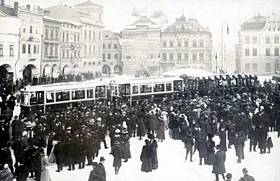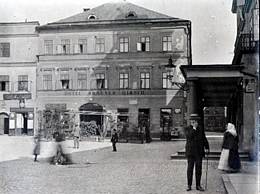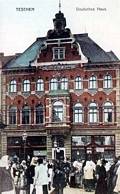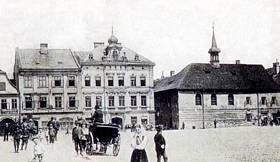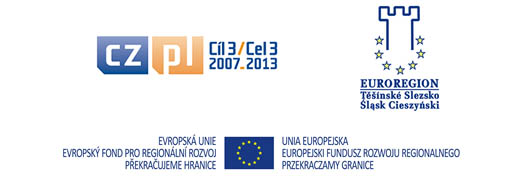Constitutional Government - more information
The outbreak of the Springtide of Nations in 1848 and the March Revolution in Vienna caused intense reaction in Cieszyn. Cieszyn men joined the National Guard in great numbers. It was supposed to keep law and order in the town and protect the democratic changes achieved then. For the first time Cieszyn citizens could elect their own representatives to representative bodies (parliaments in Frankfurt, Vienna and Opava); free elections for the local authorities also took place. Local newspapers were launched; the first being Tygodnik Cieszyński, which came out in May 1848, and was edited by Paweł Stalmach from August of that year. After the collapse of the Springtide of Nations, Stalmach started publishing Gwiazdka Cieszyńska at the end of 1851, and the Polish nationalistic movement began to organise itself around it.
Fundamental changes in the functioning of Cieszyn and its built environment took place from 1859 after the reinstatement of constitutional governments in the Austrian Monarchy (after 1867 the Austro-Hungarian Monarchy). This coincided with the period of the most intensive economic and demographic development in Cieszyn – the capital of Cieszyn Silesia which grew dynamically in the latter half of the 19th and the beginning of the 20th century. Several large factories were located in Cieszyn itself. The largest of them, J. and J. Kohn’s bent wood furniture factory employed about 2,000 workers at its peak. Other firms included furniture manufacturers (J. Pohlner’s, E. Skřivanek’s), a few printing houses (led by Prochaska’s), numerous photographic studios and liqueur distillery. The town’s location was its biggest asset, as it was a commercial centre on important trading routes, as well as being traditionally a centre of education and culture. From the end of the 19th century Cieszyn became a popular stopping off point for tourists. The population of Cieszyn doubled. In 1849 the town had about 7,000 citizens, in 1869 almost 10,000; the 1900 census recorded 17,000 people and the next one in 1910 – 20,500. In addition there were 2,000 soldiers from the local garrison.
In accordance with the new political and legal order citizens of the monarchy, irrespective of their nationality or religion, possessed civil rights; they could also manage their own affairs independently. The town was run by the Town Council elected every three years, which appointed an Executive Board from among its own members, led by the mayor. The mayors at that time were: Dr. Johann Demel (1861-1892 including a break of several months), his son Dr. Leonhard Demel (1892-1908 and 1913-1915) and Dr. Rudolf Bukowski (1908-1913). They managed the daily affairs of the town which at that time turned into a modern urban centre with an efficiently functioning communal infrastructure. Many public buildings, such as the town hall, local government and state administration offices, schools and churches were built or remodelled. A variety of new, previously unknown buildings for example hotels, banks, a local slaughterhouse, water supply and a large municipal cemetery were built. The first gas and then electric lighting was introduced in 1910. A great deal of new buildings, social care institutions and a few hospitals were erected due to the support of state and church institutions, active associations and individuals. The biggest hospital, founded in 1892 by Pastor Theodor Haase as the Lutheran General Hospital, was later taken over by the Silesian authorities in 1903 (currently Szpital Śląski). The town’s appearance was taken care of; a few attractive parks and monuments were founded in public places. Almost all the townhouses within the previous town walls were built anew and were mainly modelled on Viennese Art Nouveau. Order in the town was kept by the police and the municipal police; after 1871 a voluntary fire brigade and medical emergency services operated in the town. The increasingly numerous hotels and inns offered their services to meet the needs of the growing crowds of tourists visiting the town; the most elegant of which was the Pod Brunatnym Jeleniem Hotel. Hackney-cabs, whose drivers were called fiakrzy (from the French fiacre – a kind of horse-drawn carriage), provided transport around the town. Their number amounted to 10 in 1899 and increased to 26 in 1910. The first car (called an automobil in Polish at that time) – a Mercedes – toured the town in 1908.
The construction of the Koąice-Bohumin railway and the railway station on the left bank of the Olza in 1869 were of great significance; in 1886 another line was added which connected Kalwaria Zebrzydowska with towns in Moravia through Bielsko, Cieszyn and Frýdek. The suburbs lying on the left side of the river quickly transformed into the town’s industrial district. In 1910 almost one third of the town’s population lived here and many modern factories were established, one of them Fritz Kutzer’s printing house. Saska Kępa (also called Sachsenberg), the main street leading from the main bridge beside the castle to the railway station, prospered the most. In 1911 a tramway line was ceremoniously opened; it linked the railway station with ul. Wyższa Brama via the current Most Przyjaźni (Friendship Bridge), ul. Głęboka and the Town Square. In former times the communication between the town centre and the railway station was conducted by horse omnibuses mainly carrying passengers to hotels.
In the second half of the 19th century Cieszyn also became an important centre of education and culture. Sixteen elementary schools, three grammar schools and three seminaries operated in the town and large numbers of their former pupils continued with a university education, particularly in Vienna. There were nine Catholic churches, one Lutheran church and two Jewish synagogues. For this reason Cieszyn was called ‘the town of churches and schools’. The Deutsches Theater, with a permanent company of actors, was completed in 1910. Previously theatre performances had been staged in a room by the town hall or in hotels. In 1901 in addition to Fr. Szersznik’s Library and Museum, a Municipal Museum was created and further collections of art and historical memorabilia were gathered by numerous Cieszyn associations and private individuals. The private museum of Bruno Konczakowski, an ironmonger, deserves special attention.
In constitutional times a few publishing houses existed in Cieszyn, a large number of newspapers and magazines were published, representing the various political and nationalist views of the town’s residents. A considerable amount of the books published in the town were written by local authors in different languages. The following ones deserve mention; the poets Paul Lamatsch von Warnemünde, Friedrich Uhl (who later worked in Vienna) and Jan Kubisz, the writer Edith Schmettan, the historians Mathias Kasperlik, Gottlieb Biermann, Frantiąek Slama and Franciszek Popiołek. Eduard August Schroeder was a scholar known throughout Europe. Three painters who became famous were; Edward Świerkiewicz, Ida Münzberg and Henri Adell Trouck (born in Paris). Several music schools in Cieszyn – Slawik and Pogrobiński’s being the best known of them – provided a good musical education to many artists. Several of them brought Cieszyn fame when they performed on stages all over the world, such as the singer Rosa Pauly or the violinist Max Rosthal – the “Cieszyn Paganini”. At the turn of the 20th century the people of Cieszyn kept up to date with events in their capital city i.e. Vienna. Political and social life was styled after Viennese newspapers and fashion. The several visits made by Emperor Franz Joseph I and other members of the ruling dynasty to Cieszyn were great events.
Cieszyn’s middle class took an active part in the political and social life of their own town and beyond. Before the First World War 179 registered associations were active in Cieszyn. The German minority was guaranteed absolute power in the town thanks to their economic status, the support of the Jewish community and, above all, the curial electoral system. During the times of Austrian rule the German Liberal party dominated in the political life of the town. Their organ was Karol Prochaska’s weekly and later the daily newspaper Silesia. Mayors were elected from among the Liberals in the Deutsches Verein, and the German Scholastic Union also played a significant role. After 1898, German institutions and associations were based in the Deutsches Haus in ul. Głęboka (today the Public Library). So-called ślązakowcy were also active in Cieszyn: this group was made up of Polish families who nonetheless closely identified with German culture and language. In 1910 they established their own Dom Śląski in Górny Rynek. The Snaha Club, founded in 1882, represented the aspirations of the Czech minority who constituted 6% of the town’s population. At the turn of the 20th century a Hungarian community drawn from officers from the local garrison and the officials of the Koąice-Bohumin railway was very active in the town. They even founded their own Hungarian Club promoting Hungarian customs and culture in Cieszyn.
The most numerous group of Cieszyn residents was the Polish-speaking population although, according to the official statistics, in 1900 only 34 % of the town’s population considered the Polish language as their mother tongue (according to the estimates of Polish activists the number amounted to 60 %). The Polish nationalistic movement in the latter half of the 19th century grew in strength and the most important Polish institutions, apart from the Polish press headed by Gwiazdka Cieszyńska, were the Czytelnia Polska Ludowa (the Polish People’s Library founded in 1861), Towarzystwo Oszczędności i Zaliczek Co-operative Bank (1873) and Macierz Szkolna Księstwa Cieszyńskiego (1885). They were all based in Cieszyn but influenced the whole of Cieszyn Silesia. In 1901 in the former Pod Czarnym Orłem Inn in the Town Square, Polish activists established Dom Narodowy (National House) which from then on housed all the Polish organizations and associations. The majority of the leaders of the Polish nationalistic movement also lived in Cieszyn, including Paweł Stalmach, Ignacy Świeży and Józef Londzin. The achievements of the Polish nationalistic movement, among them seats in the Opava and Vienna Parliaments, were not reflected in the municipal elections in Cieszyn. Only in 1913 was the first representative of the Polish nationalistic movement elected to the Cieszyn Town Council, and then only as a deputy. Despite opposition by Cieszyn’s municipal authorities the first Polish gymnasium was successfully opened, then the Polish elementary school (currently in ul. Świeżego), and then further Polish educational institutions.
Before the First World War Cieszyn had a population of twenty thousand (not counting almost two thousand soldiers in the town’s garrison) and was a rapidly developing modern town. It was also the capital of Cieszyn Silesia, a very developed region, where the agricultural areas in the east and south were complemented by the heavy industry of the Karvina industrial region and Bielsko. The intense political and social life was dominated by ethnic disputes which, however, did not disable joint efforts for the good of the town. During the First World War Cieszyn once again became a familiar name in Europe as the headquarters of the Austrian Command in the years of 1914 - 1917.
J. Spyra, transl. D. French

